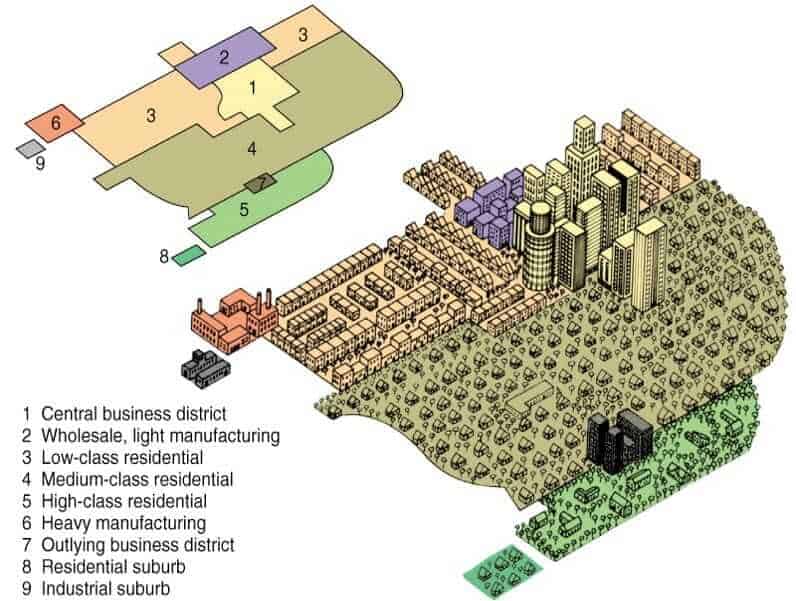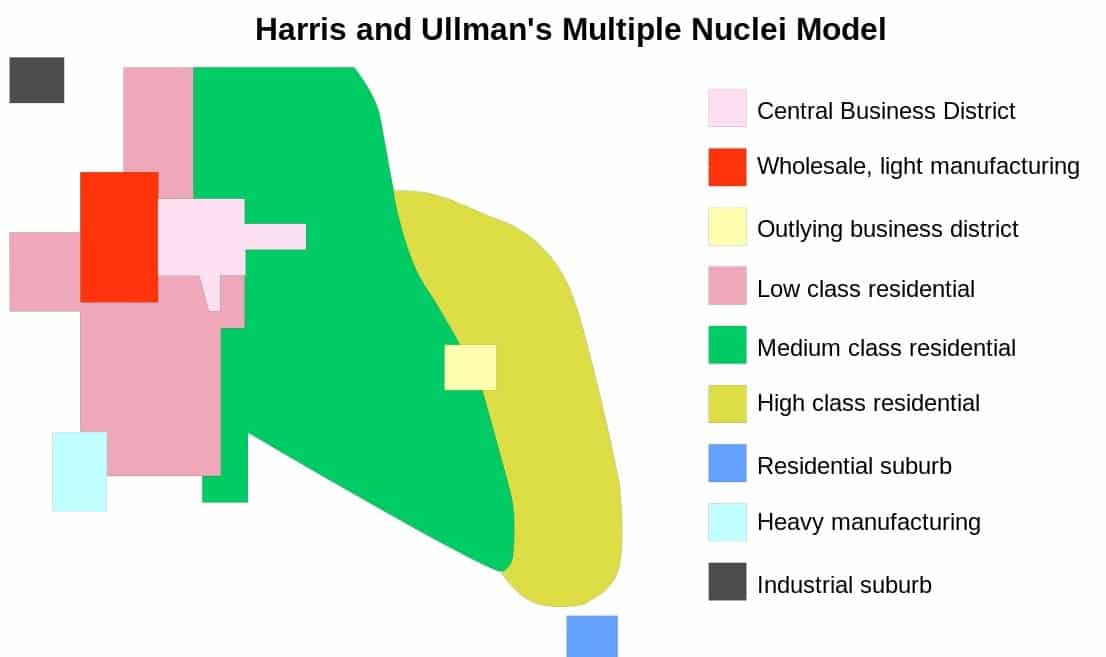Multiple Nuclei Model Harris and Edward Ullman of 1945
Multiple nuclei model of 1945 by C.D. Harris and Edward L. Ullman is based on the argument that the cities have multiple growth points or “nuclei” around which growth take place. This model was given in an article by them “The Nature of Cities.” This is one of the widely adopted models which was applicable to modern cities unlike older models studied under settlement geography. Urban settlements all over the world including the largest cities can be studied with the help of urban development models.
As the cities expand and urban development takes place, cities undergo various changes. The urban form and urban footprints gets modified over time. The structure of city and land use patterns have distinct characteristics and noticeable pattern. Based on these patterns of urban land use, urban models are created which helps in understanding the reason of a particular activity or land use being observed at a particular location or region. For example all cities have dense center, central area has high land value, economic activity, vertical development in city centre etc. Such characteristics form a part of urban studies and urban land use pattern.
Concept and need for Multiple Nuclei Model
Multi Nuclei model is based on the structure of Chicago just like the Burgess model or Concentric zone model of 1925. However it is contrary to the monocentric model of Burgess Model. Harris model can be considered as an attempt to explain the structure of the city taking into account the complexity and growth over time, influence of central area & the city centre. Harris and Ullman argued that a city might start with a single central business district (CBD), but over the time the activities scatter and gets modified. The scattered activities attract people from surrounding areas and act as smaller nuclei in itself. These small nuclei gain importance and grow in size and start influencing land value and the growth of activities around them.
Related: Central Place Theory (CPT) by Walter Christaller (1933)

The need for this model was to provide a more realistic explanation of the cities. The influence of cars on personal travel and greater movement of goods offered opportunity in different places instead of concentrating all economic activities in one place. People started optimizing their business for maximum profit by locating at a different place and bringing down their rent with a slight increase in transportation cost. Whereas some activities like industrial areas create pollution and are thus preferred to be located away from residential areas. This model is considered to be more suitable for cities which are large and expanding. This model was found to be applicable to multiple cities and not just American Cities like California, New York, Chicago. Multi nuclei model could explain a few European cities as well.
Significance of Multiple Nuclei in a City
Urban growth has resulted in high rate of urbanisation. People migrate to cities because of the advantages provided by cities such as better economic opportunities, access to better health & educational facilities etc. With the growth of population and the in-migration into the cities, it is not feasible to locate all the actives in one particular area. This is largely because of the high land value, increased rent, distance from city periphery and commuting time. This results in specialised services or the activities located in the central area to get distributed. The nature, type and number of services might not be same as that being offered by the first or original city centre however the newly developed nuclei develops it’s own identity. These areas might be scattered all over the city with their own characteristics and significance. These might offer specialised service or a combination of services. These mini city centres influences urban form and the development.
Activities listed under the model
The activities listed in the model can be considered as independent zones which influences activities around them. These are also formed because of their dependence on one another when such activities are located in proximity a “nuclei” is said to be developed.
- Central business district
- Light manufacturing
- Low-class residential
- Middle-class residential
- Upper-class residential
- Heavy manufacturing
- Outlying business district
- Residential suburb
- Industrial suburb
Related: Primate City & Primacy | Relationship between city sizes
Assumptions for Multiple Nuclei Model
The land is not flat – This provides a more practical application of the multiple nuclei model and is an improvement over the Burgess model. It is difficult to find flat land for big cities, and the terrain features affects the activities, development, and direction of growth of an urban area.
Even distribution of resources – Resources are evenly distributed within the city, no one enjoys privileges or have exclusive access to resources.
Even distribution of people in Residential areas – People are distributed homogeneously and not concentrated in a particular area or pocket. This is essential as an unevenly distributed population has a direct impact on markets.
Even transportation cost – Transportation cost is even in the city and not influenced by location.
Profit maximization – A particular activity will locate itself where maximum profit can be earned. For this, a different combination of rent, transportation costs, labor cost, proximity to market may be tried, and the combination which yields the best result gives the final location for the activity. This location also takes into account the restrictions over the activity and the need to be separated from other non compatible activities such as locating residential areas away from industrial, locating large industries with more accessibility to reduce transportation cost and to ease the movement of goods.

Limitations and criticism of the Harris & Ullman’s Multiple Nuclei Model
Multiple nuclei model was considered much better than the previous simple models which attempted to explain the structure of urban areas. However, this model also had its limitations and could not be applied to many cities and did not entirely explain the structure of urban areas. Formation of well-defined zones or “nuclei” required the considerable size of the city as the small or new towns do not have a very well defined location because of which they are usually scattered. Another drawback is the limited activities which are considered in the model along with the very rigid and specific boundaries of the activities. Some other disadvantages include:
- Negligence of the height of buildings.
- Non-existence of abrupt divisions between zones.
- Each zone displays a significant degree of internal heterogeneity and not homogeneity.
- Unawareness of inertia forces.
- No consideration of the influence of physical relief and government policy.
- The concepts may not apply to Asian cities with different cultural, economic and political backgrounds.
Related: Rural-Urban Fringe, Hoyt Model or Sector Model, Galactic City Model